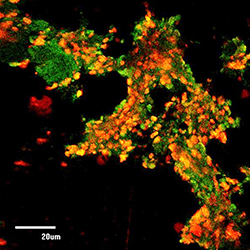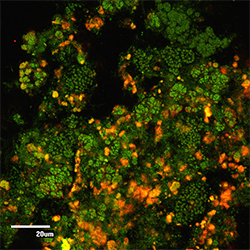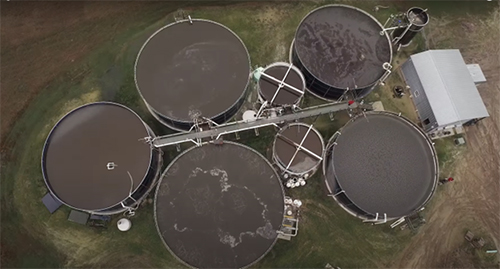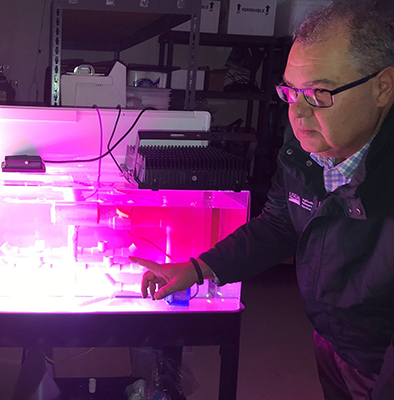
The Alchemy of Waste: Researchers Transform Animal Byproducts Into Valuable Assets
One of the great challenges of raising animals is how to handle their waste. The question is as inevitable as it is difficult, but thanks to creative thinking and persistent lab work, ARS scientists are now offering farmers revolutionary new tools. Their goal: to reduce or eliminate the negative side effects of animal waste, such as excess nutrient run-off, and the release of pathogens or even antimicrobial resistant (AMR) genes. In developing solutions, they are helping to build a more circular agricultural economy, in which farmers can transform waste into valuable products that they can then use on their land in ways that strengthen their operations.
The work includes several different projects and builds on research that has been in progress for over 25 years. It began with the insight that bacteria lurking within waste could itself contain solutions. Matias Vanotti, a soil scientist at the Coastal Plains Soil, Water, and Plant Research Center in Florence, SC, used that insight to begin an intensive screening process — over 450 days long — to isolate a bacteria in waste from swine operations in North Carolina, where there was a significant problem with run-off from farms. His search led him to a bacterial species, Brocadia caroliniensis, called anammox, for its ability to perform anaerobic ammonia oxidation, or the transformation of ammonia, a potentially harmful form of nitrogen, into dinitrogen gas under anaerobic conditions. The process proved to be highly effective for water treatment and has implications beyond agriculture, too.


Confocal microscope image of bacteria in a bioreactor that removes ammonia from wastewater: Red: anammox Brocadia caroliniensis, Green: HPNS (high-performance nitrifiers). (Photos by Marina De Pra, Federal Technological University of Paraná Dois Vizinhos)
In the course of the research, Vanotti explained, "we had to lyophilize [freeze dry], or preserve the bacteria for a long time, and that caught the attention of NASA, because they were trying to develop a new system to clean and recycle wastewater in space for long-term missions, like a mission to Mars."
The achievement has been described as "a game-changing water purification technology to remove nitrogen from wastewater at one-third the cost of existing technologies."
 Efficient manure/wastewater treatment system developed to capture nutrients, improve water quality, reduce emissions of ammonia and nuisance odors, enhance water availability for water reuse, and kill harmful pathogens. (Image from "Turning Waste into Power in Rural North Carolina", USDA Rural Development)
Efficient manure/wastewater treatment system developed to capture nutrients, improve water quality, reduce emissions of ammonia and nuisance odors, enhance water availability for water reuse, and kill harmful pathogens. (Image from "Turning Waste into Power in Rural North Carolina", USDA Rural Development)
Vanotti is now moving forward with colleagues to explore additional applications of bacteria, such as using them to treat water so that it can be used to flush barns, to purify water at very low temperatures, or even incorporating the bacteria into anaerobic digestion processes to reduce greenhouse gas emissions. In all of these efforts, the researchers are keeping the focus on the farmer. "We try to do this in such a way that a farmer can manage without complicated equipment," Vanotti said.
Thomas Ducey, a microbiologist at the Coastal Plains Soil, Water, and Plant Research Center in Florence, SC, has worked on the research with Vanotti. He noted that, while conventional water treatment uses large anaerobic lagoons and takes roughly 180 days, the system they developed can process water in tanks on a farm in 3-4 days.
 ARS soil scientist Matias Vanotti with a pilot wastewater treatment reactor. (Photo by Fei Dai, Pancopia Inc.)
ARS soil scientist Matias Vanotti with a pilot wastewater treatment reactor. (Photo by Fei Dai, Pancopia Inc.)
"Treated water in a lagoon is nothing like what comes out of the system that Matias devised," he said. "Lagoon water is still filled with solids, it has high nutrient content, it is unfit for any sort of consumption, and it still has potential pathogens in it. It’s nothing like the active treatment systems that the unit here has devised. It’s night and day."
Taken together, the projects could provide farmers with a number of powerful new options to address the effects of animal agriculture, turning an insight about one tiny bacterium into a wealth of important solutions. — by Kathryn Markham, ARS Office of Communications
